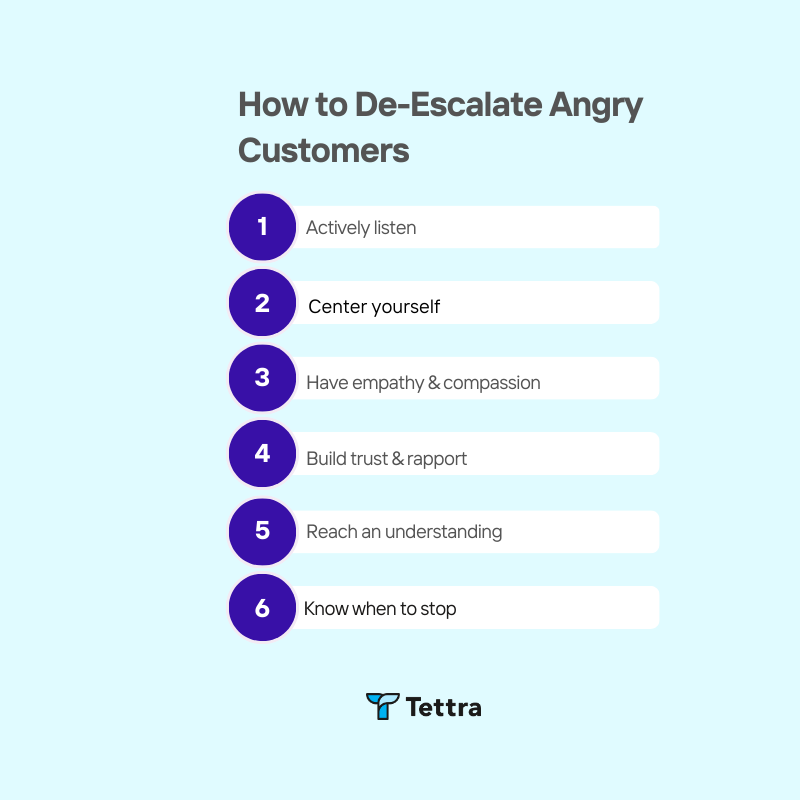After ten years in customer support, de-escalating customers is still the hardest and the most rewarding part of my job.
It’s the hardest because, unlike skills like working with APIs or troubleshooting browser issues, de-escalation isn’t always explicitly taught.
But it’s the most rewarding because all of the tools in our toolbox for de-escalating customers—empathy and compassion, active listening, clear and concise communication—are the same tools we use to build relationships.
Time spent de-escalating a customer is also time spent getting to know them, understanding their needs, and finding common ground.
I’ve found that the customers I’ve had to help through difficult conversations trust my company more, invest in our product more substantially, and become the most vocal proponents of our offerings.
The reward is worth the difficulty, so let’s skip the hard part by intentionally learning how to de-escalate customers so that they—and we—can build lasting, positive connections.
- ⭐️ Recommended: Customer service response examples to common questions
Seek to Understand by Actively Listening
The first tool in our de-escalation toolbox is active listening.
This is different from simply hearing a customer’s frustrations—we must be curious and open to discovering not only what a customer is feeling but also why they’re feeling that way.
What does active listening look and sound like?
It can differ according to the customer’s specific communication needs and the mode of communication:
- Over the phone, you might want to offer verbal cues while you’re giving the customer space to fully explain their issue so that the customer knows you’re listening. Verbal cues are unobtrusive but encouraging, like saying, “mmhmm,” “uh-huh,” and “ah.”
- Over email and chat, the cues are more substantial and deliberate. Rather than sounds, you might say things like, “Thank you for sharing that,” “Can you tell me more about…” and expressions of empathy like, “That sounds really frustrating.”
However, there are some best practices for active listening that you’ll use regardless of the communication method. Your aim should be to connect while making sure you really understand the customer’s complaints.
You don’t want to misinterpret what the customer has said or make them repeat themselves, so the focus is on gaining their trust through clear and prompt communication.
- Repeat the complaint back to the customer in your own words. This demonstrates that you’ve been listening, but it also gives the customer a chance to correct you if you’ve misunderstood their problem and gives them a chance to expand if they think of something else.
Try saying something like, “It sounds like <restate their problem>, is that right?” or “Just to make sure I understand, I think you’re upset because…”
- Ask clarifying questions. These might be about the problem the customer is upset about or about how they’re feeling about the problem. This establishes that you care about making sure you understand their issue and that you want to set things right for them.
You can try asking things like, “You mentioned X. Can you share more about that?” or “I hear that you’re angry because X. Is that right?”
The De-Escalation Process
So now we have some great basic tools in our toolbox and some best practices for using them, but what do we actually do when faced with an angry customer?
Every time you need to de-escalate an upset customer it’s by default a difficult customer conversation, and you should have a clear process for how to navigate these charged situations.
Below is the de-escalation process I recommend (and have used extensively), but if you’re a customer service leader, you should make adjustments as needed and document your team’s process in your internal knowledge base.
Center Yourself First
I can tell you from experience that it’s really hard to de-escalate a situation when you’re upset, flustered, or you’re feeling defensive.
We rarely get a heads up that a de-escalation is coming, so the best way to avoid these pitfalls when you’re interacting live with a customer is to think ahead. I also recommend role-playing with yourself or another customer support agent in safe, less intense environments.
Here are some things to practice:
- Take a deep breath at the start of every interaction, even if it’s not a difficult one.
- Smile even when you’re typing or speaking to a customer. This is a neat psychological trick: smiling can change the way you feel about a situation, infuse your voice with warmth, and gently adjust your tone when you’re upset or angry.
- Figure out your boundaries and come up with a script for enforcing them. Are you okay with a customer yelling at you? Are you okay with a customer cursing at you? I’ve learned that I don’t mind yelling, but I find a customer cursing at me upsetting and disrespectful. Knowing this, I’ve come up with a script for gently communicating my boundaries and getting customers back on track, and this allows me to be calmer and more confident even when things get thorny. I might say something like, “I understand that you’re upset, and I really want to help you, but that will be hard to do if we aren’t kind and respectful to each other. Can we take a moment to reset and try again so I can make sure you get what you need?”
Move Forward with Empathy and Compassion
Genuine empathy and compassion are fundamental tools for customer service agents. But they’re tools that are especially vital during contentious and emotionally fraught situations.
Empathy allows us to put ourselves in the customer’s place so that we can see things from their perspective.
Compassion allows us to connect with customers and understand their difficult feelings so that we can help them work through it productively.
Customer dissatisfaction—particularly dissatisfaction so great that it leads to conflict—is almost always a result of unmet or misaligned expectations. Empathy and compassion allow us to get to the root cause of those unmet expectations so that we can bring their expectations and reality into alignment, resolving the conflict they’re experiencing in a healthy way.
Build Trust and Rapport with the Customer
When you’re talking to an angry or upset customer, the first thing you want to do is give them an opportunity to explain their problem and, more than likely, vent a little.
This is your opportunity to establish trust and rapport with the customer by acknowledging their feelings early on. Not only does this show the customer that you really are on their side, but it can also have an immediate tempering effect on strong emotions like anger and frustration because the customer doesn’t have to justify their feelings to you.
By saying things like, “That sounds really frustrating,” and “I’d be mad about that too,” you’re giving customers permission to feel how they feel and someone to commiserate with. This removes any defensiveness so that you can focus on finding common ground.

Reach a Mutual Understanding
I say reach a mutual understanding rather than find a solution, because, at times, you may encounter scenarios in which there isn’t a cut-and-dry solution.
Sometimes customers are just having a bad day and have escalated an interaction because the product is not working. This is the proverbial straw that broke the camel’s back.
Sometimes they’ve had a genuinely poor customer service experience, and you’re the person who finally listened.
These are more straightforward de-escalation scenarios because the solutions tend to be more concrete. You fix the product for them, or you turn around their support experience by going above and beyond to find a resolution that works for them.
Unfortunately, it might be that you’re having to de-escalate with a customer because they’re dissatisfied with an answer or solution they’ve already been given. You may not be able to offer the resolution they want.
In cases like these, the most you can do is aim for something both of you can live with as good enough.
How do you do that?
By accurately understanding the customer’s needs, managing their expectations, and finding points of agreement.
If, say, a customer has a broken product, your task is to understand what a successful resolution looks like for them. Do they want a replacement? Do they want a refund? Are they expecting both?
If you know that both a replacement and a refund aren’t possible, it’s best to be honest and clear about that while still offering alternatives. It’s not unlike a negotiation—you give a little, they give a little, and eventually, you settle on something that’s amenable to both of you.
But remember, the important thing is to focus on points of agreement and not to go off on unproductive tangents. If a customer veers back into arguing, it’s up to you to gently steer them towards your common ground.
Know When to Stop
There’s something we as customer support professionals don’t like to admit because we’re built to help customers get what they need:
Not all de-escalations will be successful.
It may be that the customer isn’t willing to find any common ground. Or you may have a truly abusive customer, which is rare but possible.
If you’ve used all the tools in your toolbox and the interaction isn’t improving (or is actively getting worse), you need to know your support team’s criteria for stopping the conversation, either by referral or by ending the customer’s relationship with your company.
The good news is that, in my experience, it’s truly unusual for de-escalations to end this way, and it’s generally not something a support agent is expected to handle on their own. In my decade of support work, I’ve only “fired” two customers, both of which were done in my capacity as a support leader.
If you practice your de-escalation skills and focus on clear, productive communication, this scenario will be a rare occurrence, and it’s one your leadership team should actively step in to help with.
Criteria for ending a relationship with a customer or cutting short a conversation should be clearly documented in your internal knowledge base.
Anyone can de-escalate angry customers with practice
Dealing with angry customers can be scary and intimidating, but de-escalation is something that anyone can learn how to do. Like anything, it takes practice, patience, and a willingness to be empathetic, curious, and open.
So don’t shy away from difficult conversations – embrace them as chances to grow professionally and make a real difference in your customers’ experience. Over time, I think you’ll find that de-escalation becomes not just a skill but a rewarding part of being a customer support professional.
More info about customer service from Tettra
- How to empower customer service
- Top customer service metrics to track
- 17 most common customer service titles
- Customer service tips for a successful business
- How customer service teams can use Tettra
How Tettra helps your customer service team
By leveraging Tettra as your internal knowledge base, anyone across your company — even beyond customer support and customer success — can easily access relevant information and help customers be more successful.
Building a customer experience organization that drives growth for your business isn’t simple, but with Tettra, it’s way easier.
This direct access to knowledge enables team members to quickly find answers to customer queries, ensuring timely and accurate responses.
Tettra’s search and surfacing of important docs keeps the entire team informed about the latest software updates, troubleshooting techniques, and customer service protocols.
Tettra’s integration with various communication tools means that support teams can seamlessly incorporate knowledge sharing into their daily workflow, fostering a more cohesive and informed customer service experience.


